
Organic Chemistry Laboratory I
Extraction of (+) and (-)-Carvone from Oil of
Caraway and Oil of Spearmint
Experimental
Procedure
Introduction
Students will work individually
to isolate and analyze a carvone enantiomer from either oil of caraway
or oil of spearmint using a combination of column chromatography (CC)
and thin layer chromatography (TLC). All four students at each
bench will use the same oil and isolate the same enantiomer.
(Benches A, B and C will use oil of spearmint and benches D, E and F
will use oil of caraway.) Each student will analyze
products by TLC, IR spectroscopy, and calculate his or her percent
recovery of
carvone. Students will then pool their isolated carvone samples
for analysis by polarimetry. Students will be alloted two weeks
to complete the experiment. During week 1, students should
complete the TLC analysis of the crude oil, column chromatography, TLC
analysis of isolated fractions and evaporation of mobile phase from the
fractions containing carvone and limonene. Polarimetry and IR
analysis will be done during week 2.
Column Chromatography/Thin Layer
Chromatography
TLC Analysis of Oil of
Spearmint or Oil of Caraway
Prepare a silica gel TLC plate
(~2cm X 5cm) by lightly drawing a line across the bottom of the plate
with pencil. Mark the plate with three short lines, perpendicular
to the origin line. Label each line as "C" for carvone, "L" for
limonene and "O" for oil. Label three test tubes as "C", "L", and
"O" and dispense ~0.5ml of a 1% solution of carvone into the tube
labeled "C", 0.5ml of 1% limonene into the tube labeled "L" and ~0.5ml
of the oil into the tube labeled "L". Using
a microcapillary pipet, spot the plate with the appropriate solution.
Set up a small beaker containing acetone and place a KimWipe on
the bench
to rinse out the micropipet after each application, before proceeding
to the next sample. (Dip the micropipet into the acetone and
touch it to the Kimwipe to drain it. Repeat 2-3 times between
applications of the samples to the plate to be sure that the micropipet
is clean). Develop the plates in 10% ethyl acetate :
90% hexane and mark the solvent front. After the solvent
evaporates from the plate, place the plate in an iodine chamber to
stain any components on the plate. Calculate the Rf
values for carvone, limonene and the components in the oils. Identify
the components in the oil by comparison of the Rf values of components
with carvone and limonene.
Column Chromatography of Oil of Spearmint
or Oil of Caraway
Column chromatography will be
used to isolate carvone and limonene from caraway or spearmint
oil. Clamp an empty column (20ml
syringe) to a ring stand. Plug the
outlet inside, on the bottom of the column, with a small piece of
cotton or glass wool and
place a 50 or 100ml beaker or Erlenmeyer flask under the column.
Set up a test tube rack with twenty 13 X
100 mm
clean and dry test tubes. Label the tubes 1-20 with a permanent
marker
along the top rim of the tube. Set the rack aside. Prepare
a slurry
of silica gel (7.0g) in hexane (~20ml) in a 50 or 100ml beaker.
Stir
the slurry (stationary phase) and pour it into the coulmn. Allow
the
silica gel to settle and the hexane to drain from the column until it
just reaches the surface of the silica gel. Gently tap the
outside of
the column to level the surface of the silica gel. Measure a
volume of approximately 0.5 ml into a small, pre-weighed vial.
Weigh the vial and the oil, and determine the exact mass of the sample.
Record the mass in your notebook. Dissolve the oil (either
spearmint or caraway) in hexane (1ml). Using a glass
pipet,
slowly dispense the hexane/oil solution onto the column by running the
tip of the pipet around the inside diameter of the column, being
careful not to disrupt the level surface of the silica gel. Allow
the
solution to form a layer on the surface of the silica gel. Drain
the
column until the oil/hexane solution is just adsorbed onto the silica
gel. Weigh
out approximately 2g of sand and gently pour the sand onto the surface
of the silica gel to create a protective layer. Using a pipet,
add
hexane (mobile phase), a few ml at a time to ensure the oil is not
re-dissolved in the mobile phase. Begin collecting fractions into
the
test tubes. Collect ~5ml of mobile phase (approximately a half
full
tube) draining from the bottom of the column into each consecutively
numbered test tube (i.e., 5ml into tube #1, switch to tube #2, collect
5 ml, switch to tube #3 etc...). Collect ten, 5 ml fractions
(#1-10). Change the mobile phase to 10% ethyl acetate:90%
hexane.
Continue to collect 10 more, ~5ml fractions into the remaining
ten
tubes (#11-20).
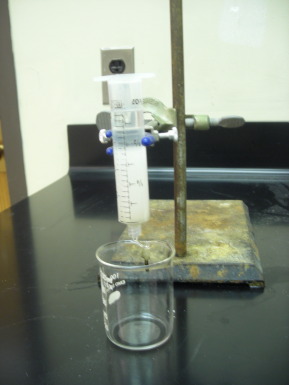
Setting up
the column
|
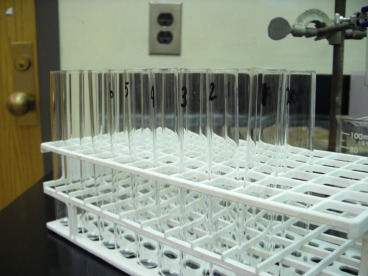
Labeled test
tubes for collecting fractions
|
TLC Analysis of Isolated Fractions from
the Column
TLC analysis is used to identify the specific components of the oil of
spearmint or oil of caraway isolated from the column. Fractions
should be evaluated for the presence of both carvone and limonene by
comparison with carvone and limonene standards. Obtain
four TLC plates (silica gel) approximately 2.5cm wide X 7cm long.
Using a pencil, draw an origin line across the first plate
approximately 1cm from the bottom. Mark the TLC plate with four short lines
evenly spaced along the bottom of the plate. Label the first mark
as "C" (carvone), the second as "L" and the remaining two marks as 1,
and 3,
corresponding to the collected fractions 1 and 3. Mark the
second plate in a similar way with four short marks along the bottom
and labeled as "C" 7, 9 and 11. Plates 3 and 4 will be marked
with the carvone and fractions C, 13, 15, and 17 (plate 3)
and C, 19 and 20 (plate 4). The
carvone will serve as a reference for the components isolated from
the column and must be included on all four plates. Using
a microcapillary pipet, spot each plate with the appropriate
fraction. Set up a small beaker containing acetone
and place a KimWipe on
the bench
to rinse out the micropipet after each application, before proceeding
to the next fraction. (Dip the micropipet into the acetone and
touch it
to the Kimwipe to drain it. Repeat 2-3 times between applications
of
the fractions to the plate to be sure that the micropipet is clean). Develop
the plates in 10% ethyl acetate :
90% hexane and mark the solvent front. After the solvent
evaporates from the plate, place the plate in an iodine chamber to
stain any components in the collected fractions. Identify which
fractions contain carvone by comparison of the Rf values of components
in the fractions with the Rf of the standard carvone. Combine all
of the fractions that contain pure carvone in a 50ml Erlenmeyer flask.
Set up a water bath on a hot plate, clamp the flask to a ring stand and
immerse it in the water bath (slightly above the surface of the hot
plate). Gently warm the solution to evaporate the solvent.
When the volume in the flask reaches ~3-5ml, transfer the solution to a
pre-weighed, clean, dry test tube (Record the weight in your
notebook). Clamp the tube to the ring stand and continue to warm
the solution in the water bath to remove the remaining solvent (to a
volume of ~0.25-0.5ml). Wipe the exterior of the tube dry and
weigh it again to determine the mass of the recovered carvone from the
oil. Calculate the percent recovery of carvone. Repeat this
process for the fractions that contain limonene.
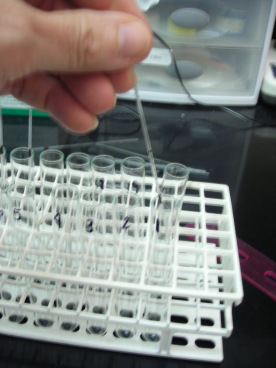
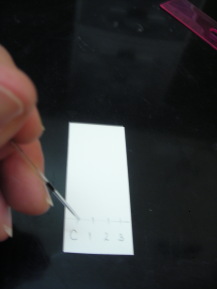
Analyzing
fractions isolated from the column by TLC
|
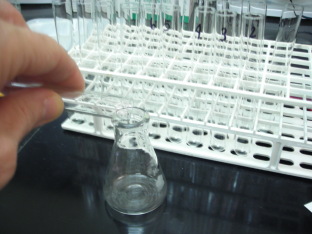
Combining
fractions containing carvone
|
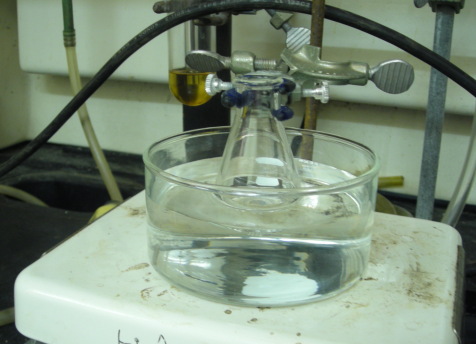
Removing
mobile phase solvent from combined fractions
|
IR Spectroscopy
After
the percent recovery is determined, the carvone and
limonene will be
analyzed by IR spectroscopy. Obtain
a set of salt plates and set one of the plates on a
Kimwipe.
Hold the plates on the sides to avoid getting fingerprints on the
plates
which can interfere with the analysis. Using a disposable, glass
pipet, place 1-2 drops of the liquid onto the center of the plate
(Figure at right). Set the second salt plate on top of the first,
distributing
the liquid evenly over the surface of the plate, creating a film.
Set
the plates in the sample compartment of the IR spectrophotometer and
run the sample. Identify the characteristic peaks in the spectrum
and determine if the experimental spectra obtained are consistent
with
carvone and limonene. Note the differences between these
spectra.
|
|
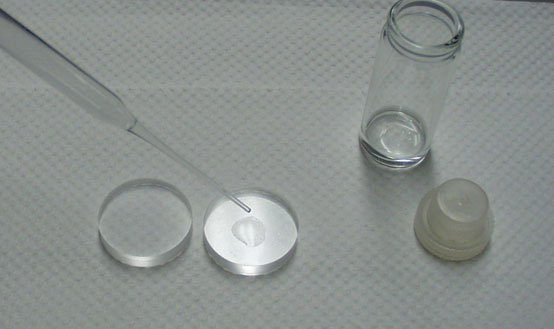
|
Polarimetry
Preparing the Sample for
Polarimetry
At each bench, collect and combine all four isolated samples of
carvone. Determine and record the mass of the pooled
sample. Transfer the pooled carvone sample into a
clean and dry 25ml volumetric flask. Use a small amount of hexane
to transfer samples (Do not exceed a
total of 10ml of hexane for the transfer). Fill the
volumetric flask to the calibration line with hexane and thoroughly mix
the solution. Calculate the concentration of the solution in
g/ml. If the solution is cloudy or turbid, filter the sample
through a disposable, glass pipet, fitted with a cotton plug before
transferring the solution to the sample polarimeter tube. Measure
~20ml of hexane into a graduated cylinder and transfer the hexane to
the
sample polarimeter tube. Mark
the level of the solution in the tube using a permanent marker
(Sharpie) (The level should be approximately 14 cm). Using a
ruler, measure the height of the solvent in
the tube and record the value in decimeters.
Return the tube to the polarimeter and record the rotation
of the blank solvent. (See below). Remove the tube from the
polarimeter and empty the contents. Transfer the
solution from the volumetric flask to the polarimeter tube. Mark
the level of the solution in the tube using a permanent marker
(Sharpie). Using a ruler, measure the height of the solvent in
the tube and record the value in decimeters.
Return the sample tube to the polarimeter and measure the
rotation. FIlter the solution to remove turbidity
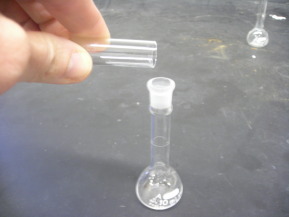
Transfer
pooled carvone sample to volumetric flask
|
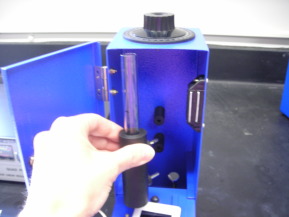
Removing/replacing
the sample tube from
the polarimeter
|
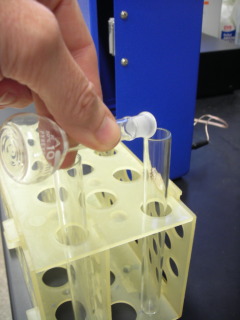
Transfer
carvone solution from volumetric flask to
polarimeter sample tube
|
Determining the Specific Rotation
Four students from each bench will pool their samples of carvone for
determination of the specific rotation. Since there can be
significant variation in the observed rotation (and thus the calculated
specific rotation), four readings of the same sample will be taken,
with each student at the bench being responsible for taking one
reading. The students will then take an average of their four
observed rotations, and use this average to calculate the final
specific rotation for the sample.
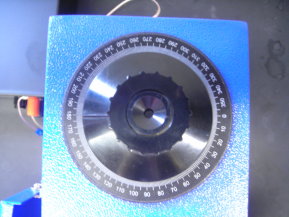
Dial on the Polarimeter
|
|
A
"rotation" must be measured for the solvent that is used in the
analysis to establish a background that will then be subtracted from
the observed rotation of the solvent plus the sample. With the
instructor's assistance, set up the polarimeter (filter, polarizer,
lamp, power source) and place the sample tube, filled with ~20ml of
hexane into the polarimetercompartment. (Mark
and measure the height of solvent (pathlength). You will need
this
value to calculate the specific rotation.) Close the door of the
compartment. Set the dial on the top of the polarimeter to 00
and check for transmittance of light. Rotate the dial in a
clockwise
direction until no light passes through (extinction) and the center of
the circle viewed through the eyepiece is dark. Move the dial
back and
forth a few degrees to determine the maximal point of extinction of
light. Record the value at which maximal extinct of light
occurs.
Four readings for the hexane should be taken, one by each student at
the bench. Calculate an average and use this value for all
calculations. Remove the sample tube from the polarimeter and empty the
hexane into a
clean beaker for re-use. Reset the dial back to zero.
Transfer ~20ml of the carvone sample in hexane from
the volumetric
flask to the sample polarimeter tube. (Fill the tube to the line
marked previously when the rotation of hexane was determined.)
Insert
the sample tube into the polarimeter. Check the dial to ensure
that it is
in the zero position. Rotate the dial clockwise until a position
of
maximal extinction is reached. Record this value. Each
student at the bench should take a reading of the sample and an
average value from the four readings determined. Use the average
value in all future calculations. Subtract the average value
obtained for hexane from the average value obtained for hexane + sample
(This
may be either a positive or negative number). Record this number
as
the observed rotation.
Calculate the specific rotation of the sample from the observed
rotation, concentration and pathlength used.
|


